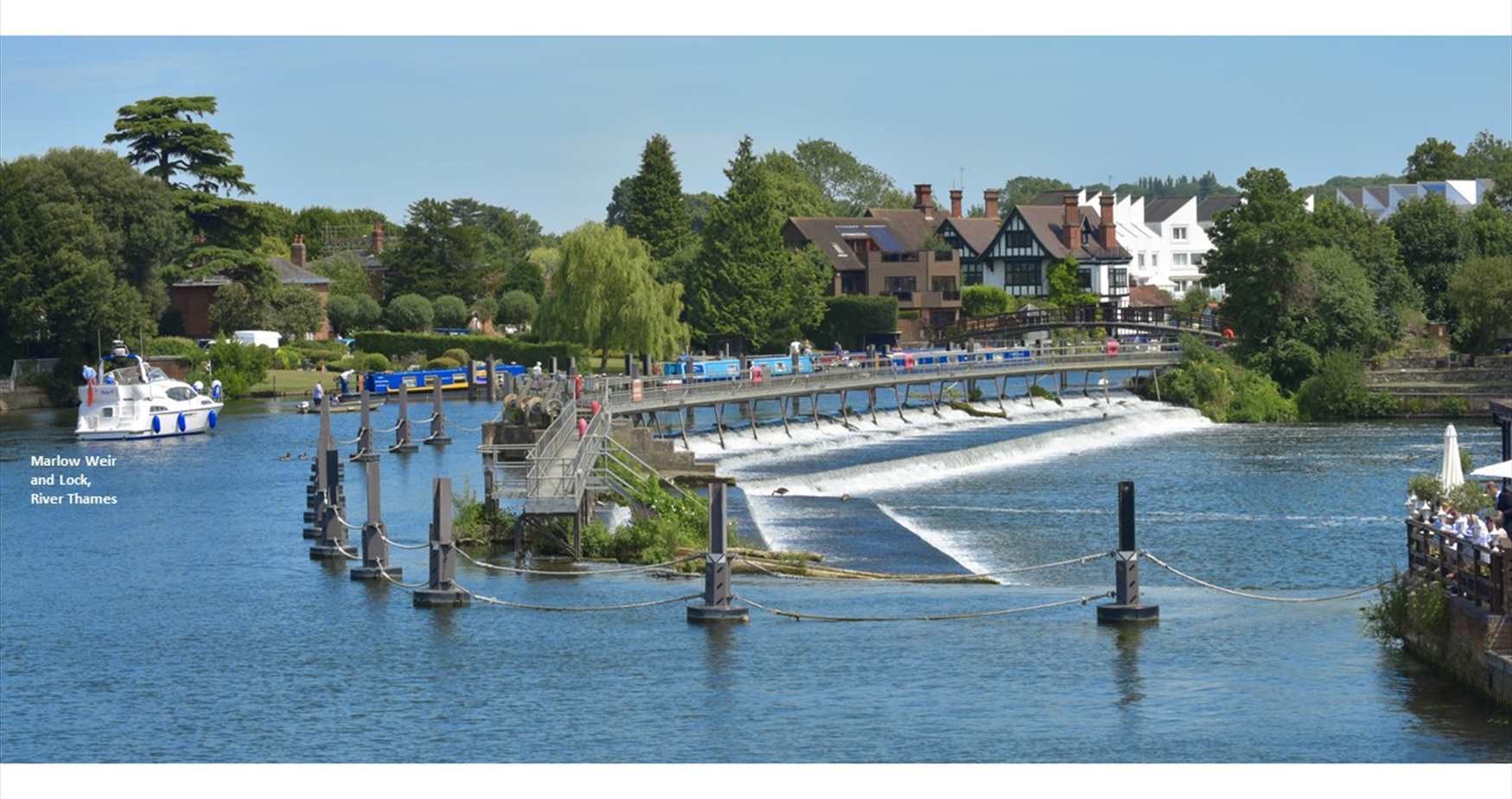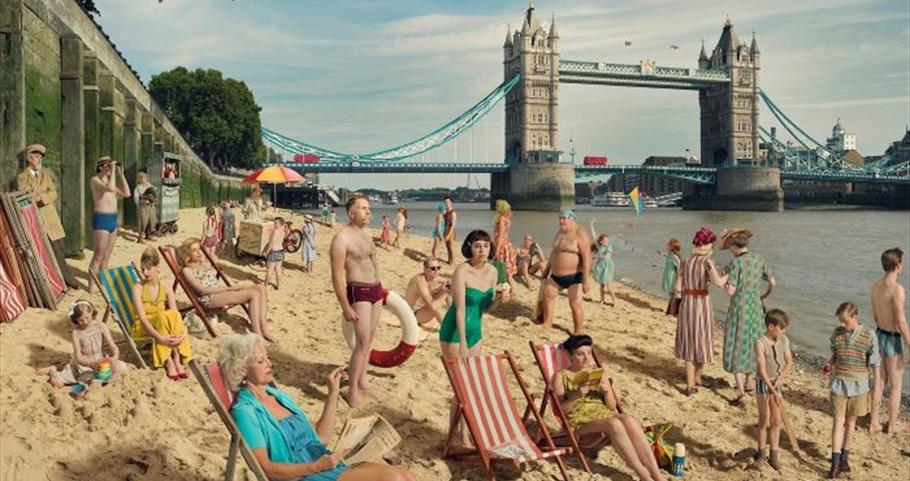You are here: About the River > Photography of the River Thames
River Thames: Photography
Photographers since Victorian times have been inspired by the River Thames, capturing its essence: its history, wildlife, landscapes, riverside, boating and people. Here is a selection through the ages.
William Henry Fox Talbot (1800-1877)
Fox Talbot is best known as the British inventor of photography and between 1 Jun 1841 and 30 Jun 1841 he took the earliest known panoramic photographic view of London – 'A view of the River Thames towards Westminster', from his flat in Cecil Street. Another Thames town is featured in his photography, Reading. Fox Talbot put Reading on the photographic map back in 1844. In Baker Street, West Reading, which used to be called Russell Terrace. The Reading Establishment was based here. It was one of the world’s first commercial photographic studios operating from 1844 to 1847. Many of the images for The Pencil of Nature by Fox Talbot, the first book to be illustrated with photographic prints, were printed in Reading.
THE WILLIAM HENRY FOX TALBOT CATALOGUE RAISONNÉ: Over a span of four decades, Professor Schaaf has examined more than 25,000 original Talbot negatives and prints in collections worldwide. The Catalogue Raisonné project seeks to make this corpus of material freely available to scholars and to the general public.
Henry Taunt (1842-1922)
Henry Taunt was a Victorian photographer and probably took over 50,000 images, mainly of Oxford and surrounding area, with a focus on the River Thames. Born in Oxford in 1842, he started work aged 11. In 1856 he joined Edward Bracher, Oxford’s first commercial photographer, at High Street Oxford. Taunt took his first photographs in 1858. In 1868 Taunt set up his own photographic business and started selling photographs of Oxford from a shop in Cornmarket Street, moving to Broad Street, and in 1875 he opened one in High Wycombe. From 1871 he was official photographer to the Oxford Architectural and Historical Society. Taunt was a keen cyclist, often cycling to photograph locations and opened a cycle shop in New Inn Hall Street. In 1893 Henry Taunt was elected a Fellow of the Royal Geographical Society in recognition of his work ‘A New Map of the River Thames’ which was first published in 1872. In the 1860sTaunt produced the first pocket guide to the River Thames to be illustrated with photographs. Between 1900 and 1914 he published a series of guidebooks of the Thames, around Oxfordshire and across Southern England. When cheap picture postcards became popular, he produced his own
Taunt died in 1922. Major collections of his work are held by Historic England: 14,000 images, Oxfordshire County Council: Oxfordshire History Centre and the River and Rowing Museum at Henley-on-Thames.
Graham Diprose and Jeff Robins were inspired by Henry Taunt’s ‘A New Map of the River Thames’ and have recaptured seventy of his finest views of the Thames from the same spots 135 years later. These have been captured alongside the originals in ‘The River Thames Revisited, In the Footsteps of Henry Taunt’, alongside commentary drawn from Taunt’s guidebooks.
Julia Fullerton-Batten
Julia Fullerton-Batten is a worldwide acclaimed and exhibited fine-art photographer was born in Bremen ,Germany, 1970 and has lived in Germany, USA, and the UK since 1986. Having lived near the River Thames in Oxford, Reading and now West London, she has become fascinated by the river. Her fascination has led to a project recreating some of the cultural and historical episodes of the Thames’ past - Old Father Thames. Each photograph is carefully researched and recreated. One of the biggest challenges was the recreation of the building of Waterloo Bridge, completed during World War II by women, and sometimes known as the ‘Ladies Bridge’.
To date, these include: 1814 Frost Fair, Ophelia after Millais, The Thames Whale, Baptism in the River Thames, Flood on the Thames, Swan Upping, Bathing by Tower Bridge, Amy Johnson, Sluts’ Hole, Sweet Message in a Bottle, Mary Wollstonecraft, The Race Box, The Grain Tower, The Ladies’ Bridge, Flooding of Tate Britain, Mudlarkers, Annette Kellerman, Durga Idol Immersion and The Lady of Shallot.
Ruth Wadey
Is a self-taught artist and photographer based in Twickenham. Ruth regularly posts her photos of the Thames and the locality on Twitter (@ruths_gallery) and these are often used by BBC and ITV weather. Take a look at her website for photographs and a selection of paintings for sale.
Annette Price
Annette is an adventure sports and wild places photographer and photographs caves, disused mines, rivers and other wild places to create storytelling images to meet the needs of magazine editors, news agencies and print buyers. Her work has been published in a wide range of magazines and newspapers including the Daily Mail, Daily Telegraph, Land Rover Owner International, the Times, BBC Focus magazine etc. and featured in a number of photographic publications.
In 2017, she began exploring the Thames from source to sea from a kayak. By being very close to the water, even getting in the water at times, she has created intimate images of the River Thames, to show how the river changes in character, growing as it flows 215 miles towards the sea. Take a look at her blog The River Within.
Terry Gibbins
Terry is a black cab driver, landscape photographer and guide who also offers photographic workshops. Discover vibrant street life, dramatic architecture and little-known landscapes on his favourite photogenic city walks. He is offering a private and unique photographic opportunity for one or two people at a time to explore London after lockdown in the safety of his Electric Taxi, you will have your own partitioned compartment with a separate A/C airflow system and 2m distancing from the driver as standard. You will be picked up and transported to various locations along the river Thames with breaks for coffees and Lunch. London provides a wealth of opportunity for Long exposure photographers with its iconic skyscrapers and watery roots, new superstructures are appearing weekly it seems, London’s skyline is constantly changing. Terry will guide you through the city and share his knowledge. Take a look at his photos, book a tour or workshop here.
London’s Found Riverscape Partnership
In 1937 the Port of London Authority commissioned a continuous photographic panorama of both riverbanks of the Thames from London Bridge to Greenwich which survived in the PLA archive and became part of their collection in the Museum of London. The 1937 PLA panorama came to the public eye in ‘London’s Lost Riverscape’ a book by Chris Elmers and Alex Werner in the late 1980s. Three photographers, Charles Craig, Graham Diprose and Mike Seaborne formed London’s Found Riverscape Partnership, with the aim of revisiting the 1937 panorama for the millennium.
In 1997, LFRP made a new panorama using 6cm x 17cm colour transparency film and also shot on 5” x 4” Black and white sheet film because of concerns about the long term archival durability and permanence of colour film. In 2000, LFRP published a book ‘London’s Riverscape Lost and Found’ with additional new text by Chris Elmers and Alex Werner and a foreword by Ken Livingstone.
In 2007 LFRP were invited to make a new screen based version of the panorama to be shown in the Museum of London’s new City Galleries opening in 2011. The Port of London Authority sponsored LFRP to make a new 2008 panorama as part of their Centenary Celebrations for March 2009 and Frances Lincoln agreed to publish a new hardback book ‘Londons Changing Riverscape’. Take a look at the website.
Thames Lens Photography Competition
An annual photography competition inviting non-professional photographers to travel onto and by the river to capture unique shots of the River Thames. Thames Lens encourages amateur photographers to seek out the life, industry, culture, sports and more that the Thames is home to.
With the tidal Thames progressively coming back to life after months of lockdown, Thames Festival Trust, in partnership with the Port of London Authority (PLA), is launching its annual photography competition inviting people to capture: the Thames Unlocked.
The theme for 2020: Thames Unlocked. The Thames was largely deserted for many weeks, save for essential port operations ensuring supplies of food, fuel and medicine flowed without interruption.Now, the river is slowly starting to come back to life as restrictions ease. As it opens up to more activity, we want participants to explore, discover and share the myriad of perspectives that the Thames offers through photography – be it via safely practiced recreational activities, river transport, community events, or even just your daily stroll. Closing date for entries is Friday 29 January 2021.
2021 Theme: My Thames Vision
2022 Theme: 'Architecture’, ‘Landscape’, ‘Nature’ and ‘People and the River’
2023 Theme: ‘Architecture’, ‘Landscape’, ‘Nature’, ‘Working River’, ‘People and the River’ and ‘Illuminated River’
.png)






